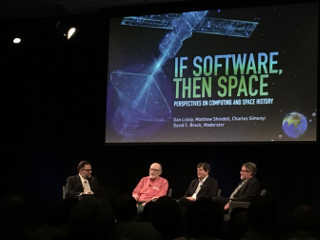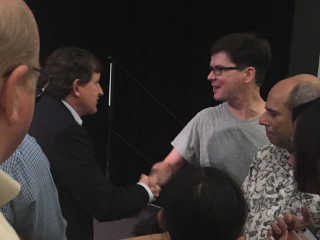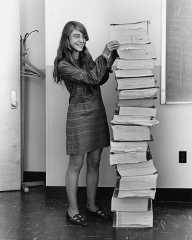
 |
Syncopated Systems™
Seriously Sound Science™
|
| Home | Services | Case Studies | About | Library | Contact |
Common Threads: Media, Science, Technology, and Other MagicMay 2020: The COVID-19 Chronicles 
If Software, Then Space panel discussion at the Computer History Museum on June 12, 2019 Champions of the Space AgeOn June 12, 2019, the Computer History Museum (CHM) in Mountain View hosted a panel discussion titled If Software, Then Space. Moderated by the Director of the museum’s Software History Center, David C. Brock, the panel included (with descriptions from CHM):
Simonyi is the only two-time space tourist, having traveled to the International Space Station (ISS) in 2007 and 2009. He is also a Stanford doctoral graduate, a former Xerox PARC researcher, creator of the applications group at Microsoft, and creator of the Hungarian notation coding style I use, especially when creating application software for Microsoft Windows. 
Simonyi (left) and I meeting at the Computer History Museum on June 12, 2019 After the panel discussion, I met panelists Simonyi and Lickly, and Lickly’s wife Margaret Hamilton, the former Director of the MIT Instrumentation Laboratory’s Software Engineering Division. When I lived in Texas, I became acquainted with Richard Garriott de Cayeux (born 1961). With his brother Robert Garriott (born 1956), father Owen Garriott (1930-2019), and friend Chuck Bueche, he in 1983 started computer game company Origin Systems. His father had been an astronaut aboard the Skylab space station in 1973 (where he pulled a clever prank) and mission aboard the Space Shuttle Columbia in 1983. Richard Garriott de Cayeux nearly became the first space tourist, but a medical issue delayed his flight to the International Space Station to 2008, between Simonyi’s two flights. In early 2003, my brother-in-law—Dr. John Tillman (whose PhD is in genetics)—was a principal investigator with an experiment aboard the Space Shuttle Columbia. He had been scheduled to load his experiment on the spacecraft prior to the launch of mission STS-107 on January 16, 2003. But because he and my sister were expecting their first child to be born around that time, he swapped roles with the investigator who would have collected the experiment after the orbiter landed. So, he was waiting for the landing with the families of the astronauts when the Space Shuttle Columbia disintegrated during atmospheric re-entry over north Texas on February 1, 2003. Less than a week later, I found myself having lunch with astronaut and retired USAF Colonel Terence T. “Tom” Henricks, who had twice piloted and twice commanded Space Shuttle missions, once each aboard Columbia. He had been scheduled to give a presentation for the annual science symposium at my school (Saint Edward’s University in Austin, Texas), but instead gave a very thoughtful and more somber memorial presentation about his time aboard Columbia. 
Hamilton in 1969, standing next to listings of the software she and her MIT team produced for the Apollo project Until 1996, I had paid relatively little attention to the space program. In early 1996, a friend I had made a few years earlier had introduced me to some of her other colleagues there as we all attended an astronomy presentation at Foothill College by pioneering finder of exoplanets (extrasolar planets) Dr. Geoff Marcy. (This presentation was a precursor to the Silicon Valley Astronomy Lecture Series founded in 1999, which is sponsored by local organizations the Astronomical Society of the Pacific, the SETI Institute, NASA’s Ames Research Center, and Foothill College.) As I recall, at the time of the presentation, there were only three known planets beyond our solar system. The first discovery of an exoplanet had been confirmed in 1992. In 1996 at Altera (acquired in 2015 by Intel), I was lucky enough to work for a space enthusiast and former Apollo program engineer named Bill Bradbury. About 30 years earlier, he had helped design an telemetric accelerator probe for the Apollo program that was sent to test the density of the Moon’s surface, presumably in order to develop an appropriate landing craft. In the 1980s, he had also contributed to the design of the control assembly on rocket packs used for extra-vehicular excursions by Space Shuttle astronauts. Even in the 1990s, Bradbury shared his fascination with space by passing around the office a book from 1991 that he, I, and many of our colleagues read and discussed, Blinded by the Light: New Theories about the Sun and the Search for Dark Matter by British science author John Gribbin (born 1946). (The book apparently has an alternate title: Blinded by the Light: The Secret Life of the Sun.) While working for Bill Bradbury, I read an interview with the science fiction author Ray Bradbury (1920-2012). After realizing that they were both from Long Beach in southern California, I asked and learned that they were second cousins. About ten years later, I shared this story with a new friend and found that she had a better boast: when she studied at Cornell University, she had lived next door to Professor Carl Sagan (1934-1996). I recall watching episodes of the 1980 Public Broadcasting Service (PBS) television series Cosmos: A Personal Voyage, which Sagan had created with Ann Druyan. They married in 1981. Druyan had been the Creative Director of the NASA Voyager Interstellar Message Project that affixed a golden phonograph record discs to each Voyager 1 and Voyager 2 spacecraft both launched in 1977. They both outlasted their five-year planned lifespans and left our solar system in 2012 and 2018, respectively. After learning to expect it from an astronomy course at De Anza College, I traveled to the Caribbean Sea to chase the shadow of a total solar eclipse on February 26, 1998. I chased another shadow of a total solar eclipse through Oregon on August 21, 2017. Later in 1998, a close friend who worked at Stanford University on the Gravity Probe B (GP-B) team introduced me to the project. Launch VehiclesIn 2013, an old friend asked for my help launching rockets into space. His team had already been reasonably successful in designing and building high-power experimental rockets, and usually launched about once per year with a considerable budget. Unfortunately, their expensive and otherwise reusable rockets had been getting lost, and the technology they used to try to track them was pretty inadequate. As I often do with new projects, I started by gathering and documenting mission parameters and requirements. Then, I researched how best to meet the requirements and drafted a proposal. In my project documents, I created and included a flight profile that included some of the notable astronometric distances. Using some of this, I recently created an updated tabular survey of astronometric data. Ultimately, I implemented a solution using mostly commercial off-the-shelf (COTS) components, some of which I modified to withstand high inertial acceleration forces. The key components included a simple but robust fault-tolerant redundant power supply system I created, a GPS receiver, and a packet radio (APRS) transmitter that went into the rocket’s nose cone, and a couple of handheld transceivers that would compare their position with the last position received from the rocket and point the way. (In 2003, I became an early integrator of GPS technology.) I also worked with another former (and nominally retired) Apollo program engineer (and many others) to create launch systems, including one that launched yeast into space for Oregon’s Ninkasi Brewing Company. This became the Ninkasi Space Program described in the 2019 book Alcohol in Space: Past, Present and Future by Chris Carberry. Bow Ties and Bull HornsIn learning how to work within the technical and regulatory requirements of this project, among other things I started learning how to read meteorological reports for aviators (METARs). Because I had already started learning this material, I wondered how much more I might need to learn to earn a pilot license and started taking lessons. (It turned out to be a lot.) On one occasion while I was a student pilot flying a Cessna 172 (which have control yokes that are typically described as looking like either bow ties or bull horns) with my instructor westbound along a Victor airway along the northern edge of the Los Angeles Basin, I saw fighter jets and thought they were part of a security detail coming to intercept me. (Flying near military bases, this was something I had to watch for. That day there was also a temporary flight restriction due to a visiting politician.) It turned out that they were the Blue Angels, who were apparently in the area for an event. For a few brief but glorious moments, all six pulled up to my left wing and allowed me to fly in formation with them. SpaceX (Almost)By 2015, the experience I had gained working on that project got me an on-site job interview at SpaceX. Before the interviews I received a personal guided tour of what I believe to be the world’s greatest rocket factory. (I didn’t get a job there; apparently I wasn’t a good fit for the job they were trying to fill.) At a gathering just a few months ago, one of my former colleagues from Sony PlayStation’s R&D department (who earned an MS and a PhD in Aeronautics and Astronautics at Stanford after a BS at MIT) shared his even-better SpaceX story: He had turned down a job offer there (apparently some time since my interview), and then had been asked to meet its CEO Elon Musk; when they met, Musk asked my friend something along the lines of “What are you going to do that is more important than saving the human race?” Next article in this series: Cars That (Nearly) Drive Themselves Previous article in this series: The First Microprocessors Back to series index: Common Threads index |
| Syncopated attempts to present a model Web site that meets or exceeds all applicable technical and legal requirements, including those of the A.D.A., COPPA, GDPR, ICANN, and W3C. | Syntax validated |
Style sheet validated |
Highest accessibility |
| “Syncopated Systems” and “Syncopated Software” are registered trademarks, the interlaced tuning forks device and the “seriously sound science” and “recreate reality” slogans are trademarks, and all contents (except as otherwise noted) are copyright ©2004-2025 Syncopated Systems. ALL RIGHTS RESERVED. Any reproduction without written permission or other infringement is prohibited by United States and international laws. | |||